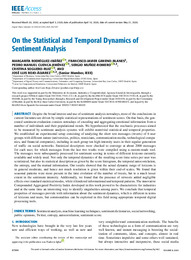Por favor, use este identificador para citar o enlazar este ítem:
https://hdl.handle.net/11000/30606Registro completo de metadatos
| Campo DC | Valor | Lengua/Idioma |
|---|---|---|
| dc.contributor.author | Rodríguez Ibáñez, Margarita | - |
| dc.contributor.author | Gimeno Blanes, Francisco Javier | - |
| dc.contributor.author | Cuenca Jiménez, Pedro Manuel | - |
| dc.contributor.author | Muñoz-Romero, Sergio | - |
| dc.contributor.author | Soguero-Ruiz, Cristina | - |
| dc.contributor.author | Rojo-Álvarez, José Luis | - |
| dc.contributor.other | Departamentos de la UMH::Ingeniería de Comunicaciones | es_ES |
| dc.date.accessioned | 2024-01-24T11:25:06Z | - |
| dc.date.available | 2024-01-24T11:25:06Z | - |
| dc.date.created | 2020-04 | - |
| dc.identifier.citation | IEEE Access Volume: 8 (2020) | es_ES |
| dc.identifier.issn | 2169-3536 | - |
| dc.identifier.uri | https://hdl.handle.net/11000/30606 | - |
| dc.description.abstract | Despite the broad interest and use of sentiment analysis nowadays, most of the conclusions in current literature are driven by simple statistical representations of sentiment scores. On that basis, the generated sentiment evaluation consists nowadays of encoding and aggregating emotional information from a number of individuals and their populational trends. We hypothesized that the stochastic processes aimed to be measured by sentiment analysis systems will exhibit nontrivial statistical and temporal properties. We established an experimental setup consisting of analyzing the short text messages (tweets) of 6 user groups with different nature (universities, politics, musicians, communication media, technological companies, and financial companies), including in each group ten high-intensity users in their regular generation of traffic on social networks. Statistical descriptors were checked to converge at about 2000 messages for each user, for which messages from the last two weeks were compiled using a custom-made tool. The messages were subsequently processed for sentiment scoring in terms of different lexicons currently available and widely used. Not only the temporal dynamics of the resulting score time series per user was scrutinized, but also its statistical description as given by the score histogram, the temporal autocorrelation, the entropy, and the mutual information. Our results showed that the actual dynamic range of lexicons is in general moderate, and hence not much resolution is given within their end-of-scales. We found that seasonal patterns were more present in the time evolution of the number of tweets, but to a much lesser extent in the sentiment intensity. Additionally, we found that the presence of retweets added negligible effects over standard statistical modes, while it hindered informational and temporal patterns. The innovative Compounded Aggregated Positivity Index developed in this work proved to be characteristic for industries and at ... | es_ES |
| dc.format | application/pdf | es_ES |
| dc.format.extent | 20 | es_ES |
| dc.language.iso | eng | es_ES |
| dc.publisher | Institute of Electrical and Electronics Engineers | es_ES |
| dc.rights | info:eu-repo/semantics/openAccess | es_ES |
| dc.rights | Attribution-NonCommercial-NoDerivatives 4.0 Internacional | * |
| dc.rights.uri | http://creativecommons.org/licenses/by-nc-nd/4.0/ | * |
| dc.subject | Sentiment analysis | es_ES |
| dc.subject | Companies | es_ES |
| dc.subject | Machine learning | es_ES |
| dc.subject | Tools | es_ES |
| dc.subject | es_ES | |
| dc.subject | Industries | es_ES |
| dc.subject.other | CDU::6 - Ciencias aplicadas::62 - Ingeniería. Tecnología | es_ES |
| dc.title | On the Statistical and Temporal Dynamics of Sentiment Analysis | es_ES |
| dc.type | info:eu-repo/semantics/article | es_ES |
| dc.relation.publisherversion | https://doi.org/10.1109/ACCESS.2020.2987207 | es_ES |

Ver/Abrir:
200420 On the Statistical and Temporal Dynamics of Sentiment Analysis - 09063439.pdf
7,77 MB
Adobe PDF
Compartir:
 La licencia se describe como: Atribución-NonComercial-NoDerivada 4.0 Internacional.
La licencia se describe como: Atribución-NonComercial-NoDerivada 4.0 Internacional.
.png)